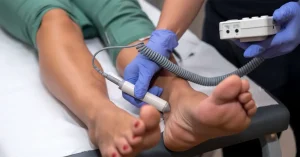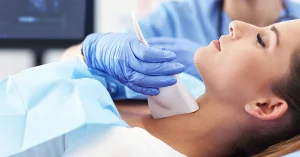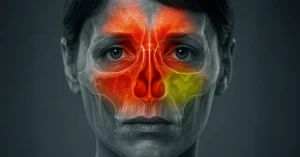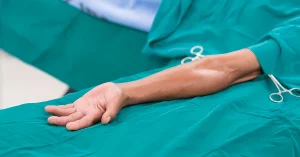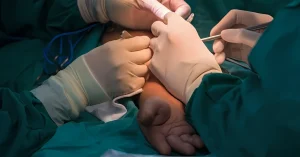Ulnar Nerve
When numbness becomes an alarm signal. Causes, symptoms and treatment options.
Home » Orthopedic Surgery » Ulnar Nerve
Conditions Treated
Hand
- Dupuytren's contracture
- De Quervain's tenosynovitis
- Rhizarthrosis (thumb arthritis)
- Carpal Tunnel Syndrome
- Ulnar nerve compression
- Synovectomy
Shoulder
- Rotator cuff tears
- Total shoulder replacement
- Acromioclavicular joint dislocation
Knee
- Total knee replacement
- Knee arthroscopy
Foot
- Hallux Valgus

Have you started to feel numbness or tingling in your little finger and ring finger? Do you sometimes feel like your hand is “slowing down” or losing its grip strength? These may be signs of ulnar nerve compression, a condition caused by pressure on the ulnar nerve, usually at the elbow or wrist.
Treatment for this condition varies depending on the severity of the symptoms and may include both conservative solutions and surgical interventions.
Book an Appointment
Ce este compresia nervului ulnar?
The ulnar nerve is responsible for sensation and fine movements of the hand, especially in the little finger and ring finger area. When this nerve is compressed, symptoms such as tingling, numbness, or even muscle weakness may occur.
Compression can occur at different levels, but the most common are:
- Cubital tunnel syndrome: compression of the nerve at the elbow;
- Guyon’s tunnel syndrome: compression of the nerve at the wrist.
Causes and risk factors
Compression of the ulnar nerve can be caused by several factors, including:
- Poor posture: prolonged leaning on the elbow or repeated flexing of the arm can put pressure on the ulnar nerve and cause irritation.
- Trauma or injury: direct injury to the elbow or arm can affect the nerve, causing compression.
- Structural conditions: Changes in anatomical structure, such as arthritis or changes in bone or ligament, can put pressure on the nerve.
- Sprains or fractures of the elbow: Any injury to the elbow can lead to a change in the position of the ulnar nerve, increasing the risk of compression.

Neuropathy symptoms ulnar nerve
Symptoms of ulnar nerve compression may include:
- Pain: occurs in the elbow, arm, or even the little finger and ring finger. The pain may be constant or intermittent;
- Numbness and tingling: these may be felt especially in the little finger and ring finger, and the sensation is usually more pronounced at night or when bending the elbow;
- Weakness: you may experience weakness in your hand, difficulty grasping or manipulating objects;
- Loss of coordination: it is more difficult to manipulate objects due to muscle weakness.
2 fingers numb on right hand
Symptoms often worsen when the arm is bent for long periods of time or when pressure is applied to the elbow.
Diagnosis of ulnar nerve compression
Diagnosis of ulnar nerve compression begins with a detailed physical examination, followed by:
- Tinel’s test: the doctor will gently apply pressure to the ulnar nerve to see if symptoms of tingling or numbness appear in the affected fingers;
- Phalen’s test: the patient is asked to bend their arm in a specific position to check for characteristic symptoms;
- Electromyography (EMG): this test measures the electrical activity of the muscles and helps detect pressure on the nerve;
- Imaging tests (MRI, ultrasound): these are useful if structural damage to the elbow or other anatomical components that may affect the ulnar nerve is suspected.
Treatment options for healing neuropathy
Treatment depends on the severity of symptoms. In many cases, surgery can be avoided if action is taken early.
Non-surgical (conservative) treatment
For mild to moderate cases, the following may be recommended:
- Rest and avoiding pressure on the elbow: it is important to avoid leaning on your elbow or other positions that aggravate the symptoms;
- Use of a splint: an arm or elbow splint can help keep the joint in the correct position, thereby reducing pressure on the ulnar nerve;
- Physical therapy: stretching and strengthening exercises for the muscles around the nerve can help reduce pressure on it;
- Medication: anti-inflammatory drugs, such as ibuprofen, can reduce inflammation and pain.
Tratamentul chirurgical
If symptoms do not respond to conservative treatments and pressure on the ulnar nerve persists, surgery may be recommended.
There are two main types of surgical procedures for ulnar nerve compression:
Classic (open) surgery (open)
- Ulnar nerve decompression: In this procedure, the surgeon removes any tissue or structures that are putting pressure on the ulnar nerve. Typically, any scar tissue or inflammatory tissue that is constricting the nerve will be excised.
- Ulnar nerve transposition: if the nerve is at risk of frequent compression, the surgeon may decide to move the ulnar nerve to a more protected position so that it is less susceptible to pressure.
Minimally invasive (arthroscopic) surgery
- Minimally invasive decompression: this procedure is performed using small incisions and special instruments, allowing the surgeon to remove the tissue compressing the nerve without making a large incision. Recovery is faster and postoperative risks are reduced.
- Minimally invasive transposition: in some cases, nerve transposition can also be performed minimally invasively, using small incisions and specialized techniques, reducing trauma to the surrounding tissues.
At the VenArt Clinic, procedures are performed using modern, minimally invasive techniques that reduce tissue trauma and speed up recovery.
Recovery after surgery for ulnar nerve compression
Early treatment of ulnar nerve compression can prevent symptoms from worsening and significantly improve the patient’s quality of life. The benefits of early treatment include:
- Prevention of permanent nerve damage: timely treatment can prevent irreversible nerve damage;
- Rapid recovery: most patients respond well to early treatment and recover completely in a short time;
- Reduced risk of recurrence: early intervention reduces the risk of symptoms returning, even with surgical treatment.
Exercises for the ulnar nerve
Ulnar nerve gliding
- Hold your arm out to the side, palm facing up.
- Bend your elbow and bring your palm toward your face (like the phone sign—thumb to your ear, little finger to your mouth).
- Optional: tilt your head in the opposite direction of your arm.
- Repeat 5–10 times, slowly and in a controlled manner.
Gentle stretching
- Stand up straight with your back straight.
- Extend your arm sideways with your palm facing down.
- Raise your fingers toward the ceiling (like a “stop” sign with your hand).
- Hold the position for 10 seconds. Repeat 3 times.
Correcting your posture at the office
- Avoid leaning directly on your elbow for long periods of time.
- Use a soft support for your forearm or elbow.
- Maintain a neutral arm posture with your elbow slightly bent (90°).
Why choose VenArt Clinic?
- Extensive experience in treating neurological and orthopedic conditions;
- Team of dedicated, empathetic specialists with a personalized approach;
- Minimally invasive techniques for faster recovery;
- Comprehensive services, from diagnosis to treatment and recovery.
Don’t let ulnar nerve compression affect your quality of life! Schedule a consultation at the VenArt Clinic to receive an accurate diagnosis and a personalized treatment plan.
Book an Appointment
Medical Team
Frequently Asked Questions
What is the ulnar nerve and what functions does it have?
It is a nerve that controls the sensitivity of the little finger and half of the ring finger, as well as the small muscles of the hand responsible for fine movements.
What are the symptoms of ulnar nerve damage?
Tingling, numbness in the little and ring fingers, weakness when gripping objects, or pain in the elbow
What causes ulnar nerve compression?
Prolonged pressure on the elbow, trauma, repetitive movements, or frequent bending of the elbow.
How is cubital tunnel syndrome treated?
Initially with rest, orthosis, anti-inflammatories and exercises. In severe cases, surgery may be recommended.
What exercises can help relieve ulnar nerve pain?
Gentle stretching, nerve gliding exercises, and avoiding direct pressure on the elbow.
When is surgery necessary for ulnar neuropathy?
When symptoms persist despite conservative treatment or signs of muscle damage appear.
How to prevent ulnar nerve damage?
Avoid prolonged support on your elbows, maintain proper posture, and take breaks at work if you use your arms a lot.

